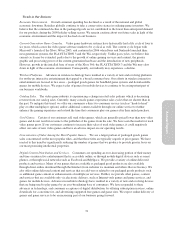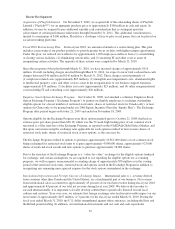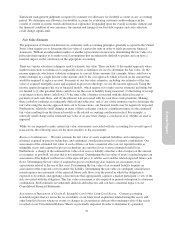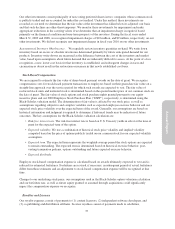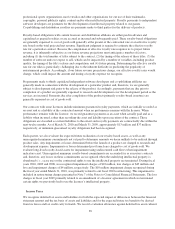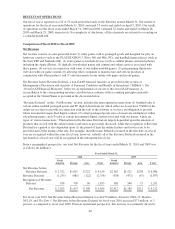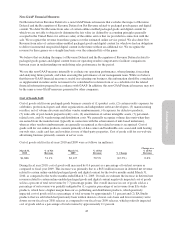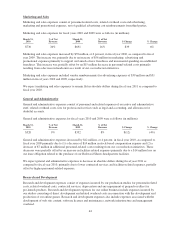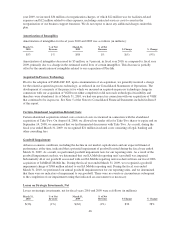Electronic Arts 2010 Annual Report Download - page 115
Download and view the complete annual report
Please find page 115 of the 2010 Electronic Arts annual report below. You can navigate through the pages in the report by either clicking on the pages listed below, or by using the keyword search tool below to find specific information within the annual report.
Annual Report
Our other investments consist principally of non-voting preferred shares in two companies whose common stock
is publicly traded and are accounted for under the cost method. Under this method, these investments are
recorded at cost until we determine that the fair value of the investment has fallen below its adjusted cost basis
and that such declines are other-than-temporary. We monitor these investments for impairment and make
appropriate reductions in the carrying values if we determine that an impairment charge is required, based
primarily on the financial condition and near-term prospects of the investees. During the fiscal years ended
March 31, 2009 and 2008, we recognized impairment charges of $10 million, and $9 million, respectively, on our
other investments. We did not recognize any impairment charges in fiscal year 2010 on our other investments.
Assessment of Inventory Obsolescence. We regularly review inventory quantities on-hand. We write down
inventory based on excess or obsolete inventories determined primarily by future anticipated demand for our
products. Inventory write-downs are measured as the difference between the cost of the inventory and market
value, based upon assumptions about future demand that are inherently difficult to assess. At the point of a loss
recognition, a new, lower cost basis for that inventory is established, and subsequent changes in facts and
circumstances do not result in the restoration or increase in that newly established cost basis.
Stock-Based Compensation
We are required to estimate the fair value of share-based payment awards on the date of grant. We recognize
compensation costs for stock-based payment transactions to employees based on their grant-date fair value on a
straight-line approach over the service period for which such awards are expected to vest. The fair value of
restricted stock units and restricted stock is determined based on the quoted market price of our common stock on
the date of grant. The fair value of stock options and stock purchase rights granted pursuant to our equity
incentive plans and our 2000 Employee Stock Purchase Plan (“ESPP”), respectively, is determined using the
Black-Scholes valuation model. The determination of fair value is affected by our stock price, as well as
assumptions regarding subjective and complex variables such as expected employee exercise behavior and our
expected stock price volatility over the expected term of the award. Generally, our assumptions are based on
historical information and judgment is required to determine if historical trends may be indicators of future
outcomes. The key assumptions for the Black-Scholes valuation calculation are:
•Risk-free interest rate. The risk-free interest rate is based on U.S. Treasury yields in effect at the time of
grant for the expected term of the option.
•Expected volatility. We use a combination of historical stock price volatility and implied volatility
computed based on the price of options publicly traded on our common stock for our expected volatility
assumption.
•Expected term. The expected term represents the weighted-average period the stock options are expected
to remain outstanding. The expected term is determined based on historical exercise behavior, post-
vesting termination patterns, options outstanding and future expected exercise behavior.
•Expected dividends.
Employee stock-based compensation expense is calculated based on awards ultimately expected to vest and is
reduced for estimated forfeitures. Forfeitures are revised, if necessary, in subsequent periods if actual forfeitures
differ from those estimates and an adjustment to stock-based compensation expense will be recognized at that
time.
Changes to our underlying stock price, our assumptions used in the Black-Scholes option valuation calculation
and our forfeiture rate, as well as future equity granted or assumed through acquisitions could significantly
impact the compensation expense we recognize.
Royalties and Licenses
Our royalty expenses consist of payments to (1) content licensors, (2) independent software developers, and
(3) co-publishing and distribution affiliates. License royalties consist of payments made to celebrities,
37






